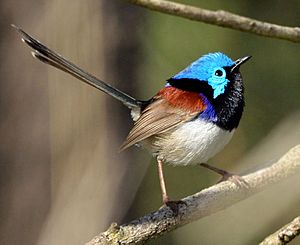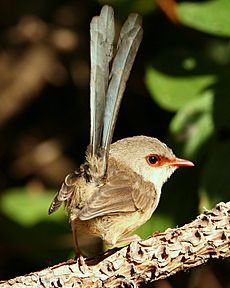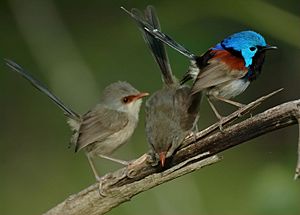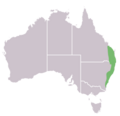Variegated fairywren facts for kids
Quick facts for kids Variegated fairywren |
|
|---|---|
 |
|
| Male in breeding plumage in Brisbane, subspecies lamberti |
|
| Conservation status | |
| Scientific classification | |
| Genus: |
Malurus
|
| Species: |
lamberti
|
 |
|
The variegated fairywren (Malurus lamberti) is a small, colorful bird that lives in eastern Australia. These birds are known for their bright colors, especially the males.
Male variegated fairywrens look very different depending on the season. When they are ready to breed, the males have bright chestnut (reddish-brown) shoulders, a shiny blue head, and blue patches near their ears. When they are not breeding, or if they are females or young birds, they are mostly grey-brown. However, females of some types can have blue-grey feathers.
Like other fairywrens, these birds live in small family groups. They work together to protect their home territory all year round. A group usually has a main pair and other helper birds that assist in raising the young. Male wrens try to attract females by picking up yellow flower petals and showing them off. Variegated fairywrens mainly eat insects. They like to live and find food in thick bushes and plants, especially in areas east of the Great Dividing Range. Until 2018, some fairywrens in central, northern, and western Australia were thought to be the same species. But now, they are known as the purple-backed fairywren.
Contents
About the Variegated Fairywren
The variegated fairywren was first described by scientists Nicholas Aylward Vigors and Thomas Horsfield in 1827. At first, some thought it was just a different color of the superb fairywren. It belongs to a group of eleven species called fairywrens, found in Australia and New Guinea.
These fairywrens are part of a group of four similar species known as "chestnut-shouldered fairywrens." The other birds in this group are the lovely fairywren, red-winged fairywren, and blue-breasted fairywren. Each of these species lives in its own area.
Even though they are called "wrens," fairywrens are not related to the "true wrens" found in other parts of the world. Scientists first thought fairywrens were related to flycatchers or warblers. But in 1975, they were placed in their own family, called Maluridae. More recently, DNA studies showed that fairywrens are related to honeyeaters and pardalotes.
The official name for this bird is "Variegated fairywren." Its scientific name, lamberti, honors a British collector named Aylmer Bourke Lambert.
How They Evolved
Scientists believe that the chestnut-shouldered fairywren group, which includes the variegated fairywren, first appeared in northern Australia. Over millions of years, as the climate changed, these birds spread out. They moved south during warm, wet periods and then became separated into different groups when it got cooler and drier. This led to new species forming, like the red-winged fairywren in the southwest and the lovely fairywren in the northeast.
The Great Dividing Range, a mountain range in Australia, acted like a big wall. It separated the variegated fairywren (which lives east of the range) from the purple-backed fairywren (which lives west of the range). In 2018, scientists officially recognized this difference, and the birds to the north and west are now called purple-backed fairywrens.
What They Look Like
The variegated fairywren is about 14 to 15 centimeters (5.5 to 6 inches) long and weighs 6 to 11 grams (0.2 to 0.4 ounces).
Males are very colorful when they are ready to breed. They have bright blue feathers on their head and near their ears, a black throat, and a royal blue back. Their shoulders are chestnut-colored, and their tail is bluish-grey. Their wings are grey-brown, and their belly is creamy white. These bright colors are very important when males try to attract a mate.
Males that are not breeding, females, and young birds are mostly grey-brown. All males have a black beak and a black area around their eyes. Females have a reddish-brown beak and a bright reddish-brown area around their eyes. Young males get black beaks by six months old. They start to get their bright breeding colors in their first breeding season, but it might take a year or two to get their full bright plumage.
Both male and female birds change their feathers (moult) after breeding in the autumn. Males then wear their duller, non-breeding feathers. They moult again in winter or spring to get their bright breeding feathers back. The blue feathers of the breeding males are very shiny and reflect ultraviolet light. This means other fairywrens, who can see UV light, might see them as even brighter and more colorful!
How They Communicate
Variegated fairywrens use their voices to talk to each other within their group and to protect their territory. Their main song is a high-pitched, fast sound that lasts 1 to 4 seconds. It's one of the softest songs among fairywrens.
They make soft tsst or seeee calls to stay in touch with each other. If there's danger, they make a short, sharp tsit sound as an alarm call.
Where They Live
Variegated fairywrens live in areas with lots of thick plants and bushes that provide good cover. They have even been seen hiding in animal burrows to escape extreme heat.
In cities, these fairywrens seem to prefer areas with more plant types, not just dense bushes. They usually don't live in pine or eucalyptus tree farms because these places don't have enough undergrowth (small plants and bushes) for them to hide in.
Their Daily Life
Like all fairywrens, the variegated fairywren is always busy looking for food. They often search on the ground near bushes or among the lower leaves of plants. They move by hopping and bouncing, using their relatively large tail to help them balance. Their tail is usually held upright and is rarely still.
Their short, rounded wings are good for quick, short flights, but not for flying long distances. During spring and summer, they are active in bursts throughout the day, singing while they look for food. Since insects are plentiful, they can rest between their feeding times. The group often rests together in a sheltered spot during the hottest part of the day. In winter, food is harder to find, so they spend most of the day looking for it.
Courtship and Breeding
Male variegated fairywrens have a special way to impress females. They carry brightly colored petals, usually yellow, and show them to the females as part of a courtship dance. They might even show petals to females in another bird's territory!
The variegated fairywren is a cooperative breeding species. This means that pairs or small groups of birds live together and protect their territory all year. Both male and female parents feed the young equally. Helper birds in the group also assist in defending the territory and feeding the young. Birds in a group often roost (sleep) close together in thick bushes and preen (clean) each other's feathers.
Life Cycle
Variegated fairywrens breed from spring to late summer. Their nest is usually hidden in thick plants, less than 1 meter (3 feet) off the ground. It's a round or dome-shaped nest made of loosely woven grasses and spider webs, with an opening on one side. They might have two or more groups of babies in one long breeding season.
A female lays three or four matte white eggs with reddish-brown spots. Each egg is about 12 by 16 millimeters (0.5 by 0.6 inches). The female sits on the eggs for 14 to 16 days until they hatch. Once the babies hatch, all the birds in the group help feed them and keep the nest clean for 10 to 12 days, until the young birds are ready to fly (fledge). The parents and helper birds will continue to feed the young for about one month after they fledge.
Young birds often stay with their family group as helpers for a year or more before they move to another group. However, some young birds might leave and breed in their first year. Variegated fairywrens are sometimes tricked by other birds, like the Horsfield's bronze cuckoo or the brush cuckoo, who lay their eggs in the fairywren's nest for the fairywrens to raise. This is called brood parasitism.
What They Eat
Variegated fairywrens eat many kinds of small creatures, mostly insects. This includes ants, grasshoppers, bugs, flies, weevils, and different types of larvae (young insects). Unlike superb fairywrens, who often look for food on the ground, variegated fairywrens mostly search for food deep inside bushes that are less than 2 meters (6.5 feet) tall.
Dangers They Face
Many animals try to eat fairywren nests, eggs, or young birds. These predators include Australian magpies, butcherbirds, laughing kookaburras, currawongs, crows, ravens, and shrike-thrushes. Mammals that were brought to Australia, like red foxes, feral cats, and black rats, also hunt them.
When a predator is near their nest, variegated fairywrens have a special trick. They do a "rodent-run" display to distract the predator. They lower their head, neck, and tail, spread their wings out, and fluff up their feathers. Then, they run very fast while making a continuous alarm call. This makes them look like a small, injured animal, hopefully leading the predator away from the nest.
In Culture
The variegated fairywren was featured on a 45-cent postage stamp in Australia. It was part of the Australia Post Nature of Australia – Desert series, released in June 2002.
Images for kids
See also
 In Spanish: Maluro variegado para niños
In Spanish: Maluro variegado para niños






